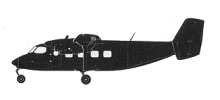Incident Overview

Description
Two AN-28 turboprop aircraft, operated by Rigas Aeroklubs Latvia, were dropping parachutists at the National Parachute Sport Centre, ?stre ra airstrip in ?sterdalen, Norway. The company had had a great deal of experience with this type of operations, and had been carrying out parachute drops in Norway each summer for the last 9 years. On Friday morning, 16 July 2004, the weather conditions were good when the flights started. They first performed six routine drop flights. After stopping to fill up with fuel, normal preparations were made for the next flight with 20 parachutists who were to jump in two groups of 10. The seventh departure was carried out at time 13:05. The Commander asked for and was given clearance by the air traffic control service to climb to flight level FL150. The parachutists were then dropped from that altitude. The first drop of 10 parachutists was made on a southerly course above the airstrip, and the aircraft continued on that course for a short time before turning through 180ø and getting ready for the next drop at the same location on a northerly course. A large cumulonimbus cloud (CB), with precipitation, had approached the airfield from the north at this time. To reach the drop zone above the runway, the aircraft had to fly close to this cloud. The aircraft was not equipped with weather radar. The last parachutists to leave the aircraft were in a tandem jump that was being filmed on video. The film showed that the parachutists became covered in a layer of white ice within 2-3 seconds of leaving the aircraft. The ice on the parachutists only thawed once they had descended to lower altitudes where the air temperature was above zero. Once the parachutists had jumped, the aircraft was positioned close to the CB cloud at a low cruising speed. They were exposed to moderate turbulence from the cloud. The Commander started a sudden 90ø turn to the left while also reducing engine power to flight idle in order to avoid the CB cloud and return to ?stre ra to land. At this point, the First Officer observed that ice had formed on the front windshield, and he chose to switch on the anti-icing system. He did this without informing the commander. A few seconds later both engines stopped, and both propellers automatically adopted the feathered position. The pilots had not noticed any technical problems with the aircraft engines before they failed. During the descent, the first officer, on the commander’s orders, carried out a series of start-up attempts with reference to the checklist/procedure they had available in the cockpit. The engines would not start and the commander made a decision and prepared to carry out an emergency landing at ?stre ra without engines. The runway at ?stre ra is 600 m long and 10 m wide. The surrounding area is covered by dense coniferous forest and they had no alternative landing areas within reach. Because they were without engine power, there was no hydraulic power to operate the aircraft’s flaps. This meant that the speed of the aircraft had to be kept relatively high, approx. 160-180 km/h. The final approach was further complicated because the commander had to avoid the last 10 parachutists who were still in the air and who were steering towards a landing area just beside the airstrip. The commander first positioned the aircraft on downwind on a southerly course west of the airfield, in order then to make a left turn to final on runway 01. The landing took place around halfway down the runway, at a faster speed than normal – according to the Commander’s explanation approximately 160-170 km/h. The commander braked using the wheel brakes, but when he realized that he would not be able to stop on the length of runway remaining, he ceased braking. He knew that the terrain directly on the extension to the runway was rough, and chose to use the aircraft’s remaining speed to lift it off the ground and to alter course a little to the right. The aircraft passed over the approx. 2.5 m high embankment in the transition between the runway level and the higher marshy plateau surrounding the northern runway area. The aircraft ran approx. 230 m in ground effect before landing on its wheels in the flat marshy area north of the airfield. After around 60 m of roll-out, the nose wheel and the aircraft’s nose struck a ditch and the aircraft turned over lengthways. It came to rest upside down with its nose section pointing towards the landing strip. The floor of the cockpit was pushed up so that the nose wheel came through the floor and partially into the cockpit. The AIBN believes the limits of the engines’ operational range were exceeded since the anti-icing system was switched on while the power output from the engines was low, in combination with low airspeed, turbulence and sudden manoeuvring. At that, both engines stopped, and the propellers were automatically feathered. The AIBN believes the engines would not restart because the Feathering Levers were not moved from the forward to the rear position and forward again, as is required after automatic feathering.
Primary Cause
Insufficient preventative measures and a failure to adequately address potential hazards due to the lack of radar and the absence of a contingency plan for unexpected weather conditions, specifically the approach of a significant cumulonimbus cloud.Insufficient preventative measures and a failure to adequately address potential hazards due to the lack of radar and the absence of a contingency plan for unexpected weather conditions, specifically the approach of a significant cumulonimbus cloud.Share on:




